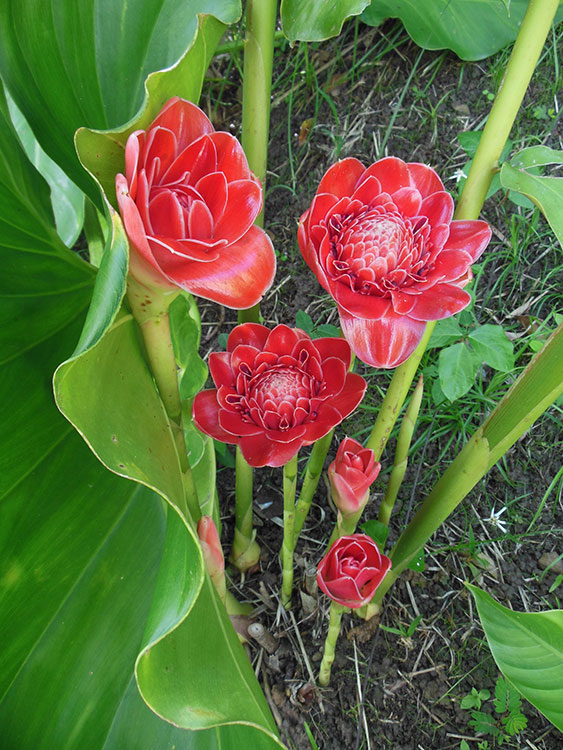Rescue for the City Weary, Treehouses in the Rainforest
LOOKING OUT OVER THE LAST TROPICAL RAINFOREST IN THE UNITED STATES FROM YOUR TREEHOUSE WINDOW AT Yuquiyú. IMAGE: ©MARTIN HAGGLAND
Martin Haggland and Yuquiyú Treehouse Retreat,
Puerto Rico
ROBERTA KRAVETTE, EDITOR
CONTACT ME
By Roberta Kravette
Is it the warm tropical breeze making music in the garden? Or are the leaves whispering their secrets ?
Legend has it that Yuquiyú himself, the Taino people’s ancient god of light and life, walked here among the trees and cloud covered peaks of the El Yunque forest.
Martin Haggland loves the Caribbean, but the object of his love is this mostly forgotten corner of the last tropical rainforest left in the United States.
✓ Trip Tips
Who: Perfect solo or couples getaway. No accommodation for children or pets. Not fully accessible.
What: Glamping, comfortable rustic, treehouses
Time: 2-night minimum
Where: Puerto Rico, USA
When: All year. Late October to August best.
How: Fly into San Juan. Drive to Yuquiyú.
Why Responsible: Clear-cut area reforested. Local hand-crafted construction and management. Recycling including grey water Site-grown, plant-based, locavore cuisine, local chief.
Secret: Island artists are periodically in-residence here.
Sometimes a Tree Calls
Mostly I thrive in the noise and electricity of the city, but sometimes the traffic, deadlines, work, family, and incessant “smart-phone” disruptions wear me down. That is when my over-heated nervous system longs for … time in a tree.
Martin’s tree. It lives in a garden on the northeastern part of the island of Puerto Rico, only a short flight from the frenetic bustle of New York City.
The Magnet that Pulls City-Tension Away
There is something about this garden, it’s like a gentle magnet that pulls the tension out from your shoulders even before you reach your tree-top home. Can you feel it, too? Your body seems lighter here as your heart begins to soar. Your eyes first widen to drink it all in, then gently close as your mind acclimates to the stillness. Ah, Peace.
But neither nature nor this garden are ever truly still.
Rainbow colored birds dart in and out of the lush green landscape. Tiny coqui, Puerto Rico’s beloved singing frogs no bigger than a penny, hide in leaves and flowers. Palms sway and the stream gurgles. Serenity.
A Place So Beautiful, “You Can Feel the Presence of God”
A GUEST ABSORBING THE LIGHT AND SERENITY OF YUQUYU. IMAGE COURTESTY OF D. ANDERSON PHOTOGRAPHY Dorian Anderson
True love can be complicated. Art is Martin’s second passion and telling in his garden that would have inspired Monet - and indeed encourages the artists and writers who regularly stay here.
“Yuquiyú” has a second meaning: “a natural place so beautiful that visitors to it can feel the presence of God.” It was worth a decade’s wait. Surely today, the ancient god of light and life is smiling on his namesake.
Slip Away to Your Refuge from Modern Life.
There are only four artisan-crafted treehouses here. Each one sleeps one or two guests only. There are never more than 8 guests on the entire property at one time.
You sleep high among the palms. Your personal sanctuary is hand built in the historical way, independent but not isolated, each with soul-renewing views of the forest or gardens and water. Ylang-ylang perfumes the air.
HAVE YOU EVER SHOWERED IN A RAINFOREST? THE VIEW, THE SMELL OF YLANG-YLANG, THE SOFT AIR, YOU WILL NEVER WANT TO LEAVE. IMAGE: ©MARTIN HAGGLAND
In His Own Words: Martin Haggland on Yuquiyú
Roberta: What three words best describe you?
Martin: Art lover, nature lover, lover of human diversity. I guess I’m cheating because that’s three phrases, not words.
THIS SMALL, RUSTIC RETREAT IS NOT FOR EVERYONE, BUT FOR THOSE WHO SEEK A COMFORTABLE REFUGE EMBRACED IN NATURE, FEW PLACES ON EARTH COMPARE. IMAGE: ©MARTIN HAGGLAND.
What Is It about Puerto Rico that Drew You Here?
Martin: I am attracted to Latin culture. I live part of the year in New York City, so convenience was another factor. But mainly it’s the CARIBBEAN! The wonderful climate, the relaxed lifestyle and, in the case of Puerto Rico, its natural beauty and rich cultural heritage going back thousands of years with the Taino natives and five centuries with the Spaniards and Africans.
Martin: From the U.S., travel is quick and without immigration delay, which means more time in nature and less in airplanes and airports. From New York, it’s 4 hours of flight time, and then a 30-minute drive on good roads.
ENDEMIC TO HISPANIOLA AND PUERTO RICO, THE ANTILLEAN MANGO HUMMINGBIRD (ANATHRACOTHORAX DOMINICUS) FLOATS AMONG THE FLOWERS. IMAGE ALFREDO IRIZZARY
Why This Particular Spot for Yuquiyú ?
Martin: I drove all around the island seven times, looking in different areas and visiting several properties that were for sale. But … El Yunque and the surrounding area of northeastern Puerto Rico is one of the most beautiful parts of the island, with its forests, rivers, waterfalls, beaches and a bio bay.
Martin: I also thought it would be great to be able to drive half an hour into San Juan for dinner or a gallery opening. San Juan is Puerto Rico’s “big city.” It has the museums, galleries, art scene, gastronomy and Old San Juan, which is a surprisingly preserved, 500-year-old Spanish-colonial town.
OLD TOWN SAN JAUN IS ONLY A SHORT DRIVE AWAY FROM YUQUIYU. IMAGE: THANKS TO THE ©PUERTO RICo HISTORIC BUILDING DRAWING SOCIETY AND MIRIAN DE LA CRUZ, GUILIA ARGENTINO AND LOURDES VELESCO.
Soft Trade Winds and Moonlight on the River
Roberta: What do you love most about Yuquiyú?
Martin: The ambiance. We have just under three acres of garden on a hilltop overlooking El Yunque Peak and the rainforest. Blessed by pure air, cooling Trade Winds and life-giving rains. An abundance of native and exotic plants … provide beauty and shade from a brilliant sun.
Martin: Then, there is the sound of the river as it cascades from the rainforest down to the ocean. At night, the little tree frogs (called coquís) begin to sing, reminding us that we share this world with a myriad of other creatures.
Martin: On nights when the moon is shining on the river, and the garden is bathed in moonlight, Yuquiyú becomes truly magical.
SERENITY, BEAUTY, AND RENEWAL ARE THE THREE WORDS MARTIN USES TO DESCRIBE YUQUYU. IMAGE: ©MARTIN HAGGLAND
What are the three words describe Yuquiyú?
Martin: Serenity, beauty, renewal.
Healing a Clearcut Rainforest: The Making of a Garden
Martin: Our property is on the edge of the rainforest. From the top of the hill to about halfway down to the river [the rainforest] was clearcut for agriculture, perhaps a century ago. The lower half has a variety of native flora.
YUQUIYU SITS ON THREE-ACRES OVERLOOKING THE RAINFOREST AND THE EL YUNQUE PEAK. IMAGE: ©MARTIN HAGGLAND
I did not try to recreate the rainforest on the upper half but saw it as a blank canvas to create a tropical garden. The dominant plants are the Puerto Rican Royal Palms (Roystonea borinquena). They [are] endemic to Puerto Rico and, especially to El Yunque rainforest. You can see them in the valley below Yuquiyú. We put in 150 or 200 in 2007 and later. Many are around 30 or 40-feet high.
From These Seeds … Renewal
Martin: I tried to plant every palm native to Puerto Rico. A few are easy to get (such as the Royal Palms), others (such as the Manaca Palm and Palmas de Sierra) came from the government conservation agency with the proviso that we collect and give them any seeds so that their nursery can propagate those species and reforest areas in the wild. A couple of species, I never did obtain.
✍︎Editors Note: The property was hard hit by Hurricane Maria, but Martin and his local team of artisans, gardeners and managers never gave up.
After the palms, the main plantings were heliconias and bromeliads. (Editors Note: most are native, a few species were brought from Hawaii]. As mentioned, I was out to create a tropical garden not to restore the rainforest. There is so much green everywhere, I primarily wanted to add color, either with the flowers (heliconias and hibiscus) or leaves (bromeliads and cordylines). We probably installed around 5,000 plants over the years, including bananas, papayas, pineapples and parchas [passion fruit]. These are intermingled with the ornamental plants.
Most of All Yuquiyú Is about Tranquility
Martin: Most of all, Yuquiyú is about tranquility — you can watch clouds swirl around rainforest peaks, walk in the woods, meditate by the river, rejuvenate in a natural pool, be enchanted by the moon and contemplate the starry night. I like to say: “Too bad Ponce de León didn’t look for the Fountain of Youth right in his own backyard — he might have discovered Yuquiyú.”
LOOK FOR ENDEMIC SPECIES, LIKE THIS PUERTO RICAN SPINDALIS, IN yuquiyu’S GARDEN. image: ©alfredo irizarry
About Yuquiyú’s Nature and Wildlife
Roberta: We love wildlife. Can you tell us about some of the birds or animals we might see in the gardens?
Editor’s Note: See more about the birds of Puerto Rico and Yuquiyú here.
Martin: We recently had a couple stay with us, both birders, who said that they saw more birds from their treehouse than anywhere in El Yunque National Forest [I have requested their bird list].
Martin: I am not a birder, but I have frequently seen the Puerto Rican Lizard Cuckoo (Saurothera vieilloti), called Pájaro Bobo Mayor in Puerto Rico; the Puerto Rican Spindalis (Spindalis portoricensis), called Reina Mora in Puerto Rico, the national bird; and the Scaly-naped Pigeon (Patagioenas squamosal), called Paloma Turca in Puerto Rico.
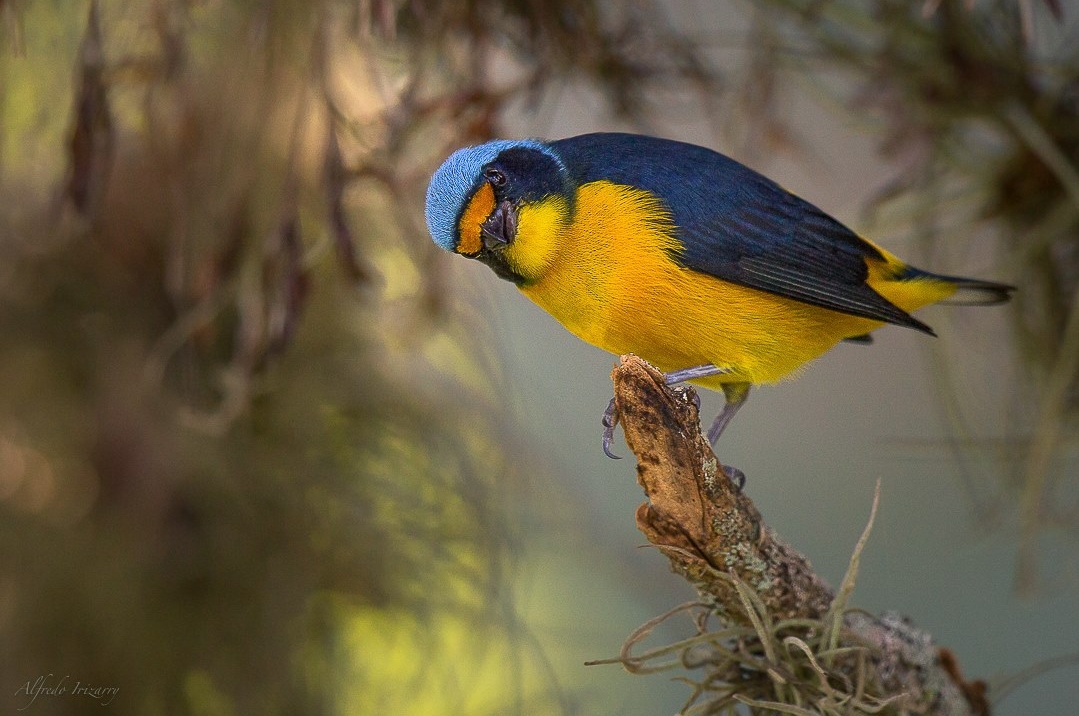
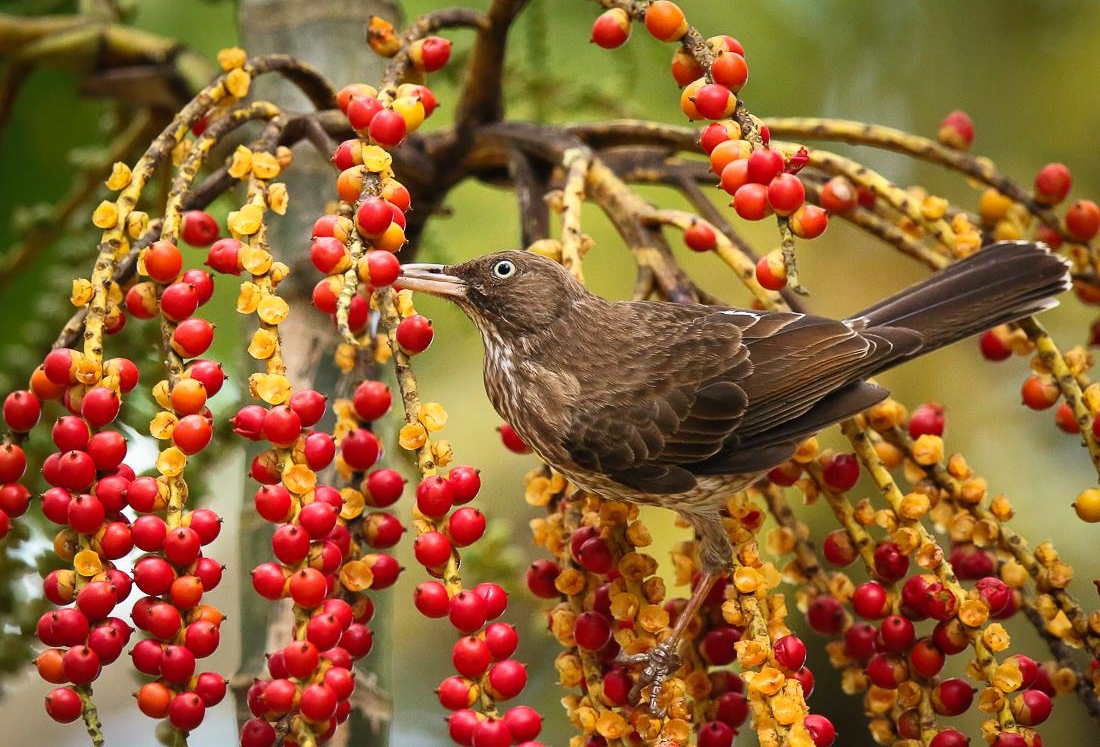
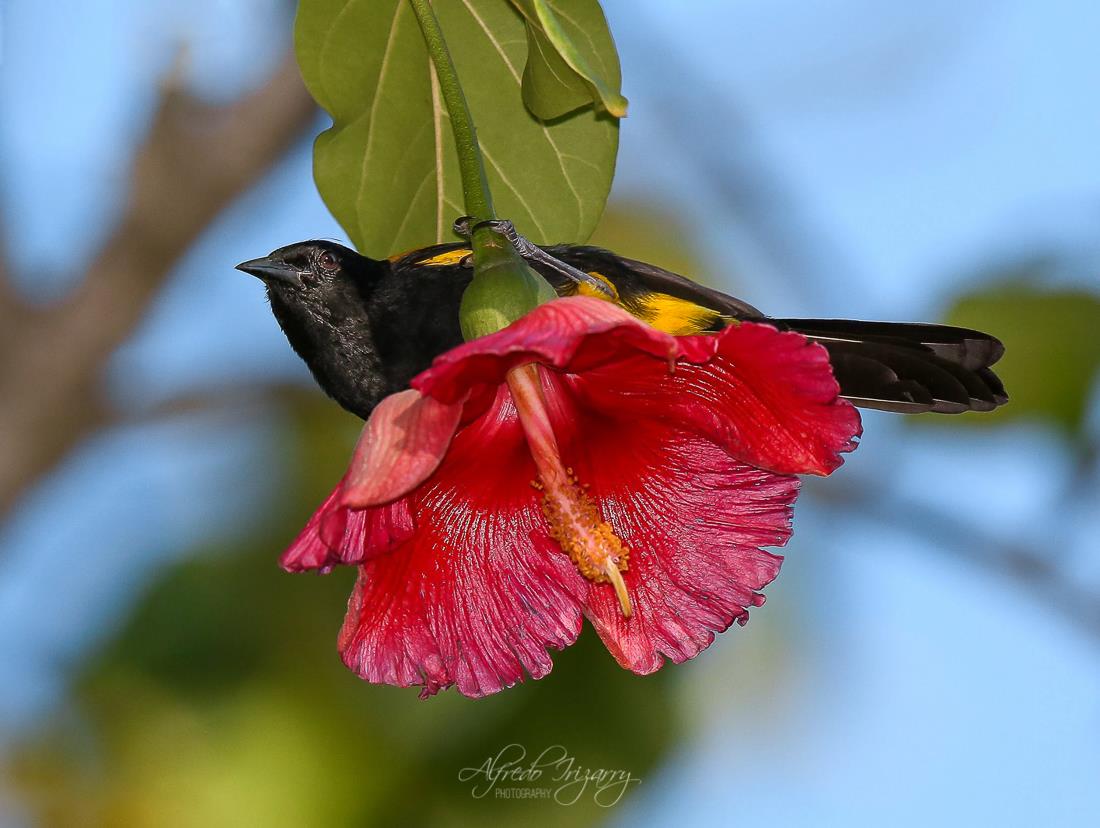
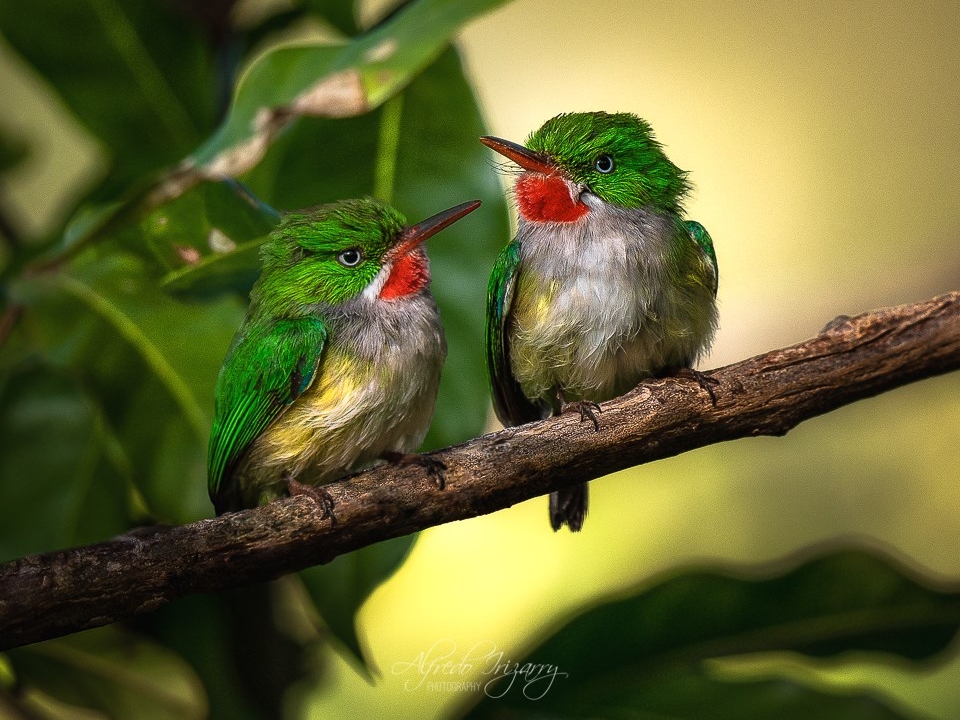


Martin: Various species of hummers are often seen, including the Puerto Rican Emerald (Chlorostilbon maugeaus), called Zumbadorcito in Puerto Rico, a hummingbird found only on the island.
LOOK FOR THIS TINY JEWEL IN THE GARDEN. PUERTO RICAN EMERALD HUMMINGBIRD FOUND ONLY IN THE PUERTO RICAN ARCHIPELAGO. IMAGE: ©ALFREDO IRIZZARY
Naturalist Rex Cauldwell on Coquí:
“The lower ‘ko’ sound is a warning to other male frogs telling them to keep their distance. Only males listen and respond to ‘ko.’ The female coqui frogs listen to the higher-pitched ‘kee’ note. When male frogs hear territorial calls from nearby male coqui frogs, they will drop the ‘kee’ part of their call and concentrate on ‘ko’ until individual frogs are spaced out to everyone's satisfaction. Then males call to female frogs with the higher-pitched ‘kee’ notes.”
Life and Love Coquí Style
But, it is perhaps, the animals you don’t see that create the greatest impression, I’m talking about the Coquí (Eleutherodactylus coqui), Puerto Rico’s beloved, singing tree frog. Rex Cauldwell, a local naturalist, explains that there are 16 species in Puerto Rico and 13 of those are in El Yunque, but only two species make the famous “ko-kee” sound: the Forest Coqui (Coquí de la Montaña) and the Common Coqui (Coquí Común).
Mostly, they sing at night, but they love water and will sing during the day after a rainstorm. They are the size of a thumbnail to an inch, so you don’t see them much. But you can see them once in a while in the pool water inside of a bromeliad or in the sink.
Colorful Neighbors
PENNY SIZED COQUÍ, PUERTO RICO’S SINGING FROGS HIDE AMONG THE LEAVES AND FLOWERS. IMAGE: THANKS TO FATHER ALEJANDRO J. SANCHEZ MUNOZ,
My favorite animal next to the Coquí is the Puerto Rican Ground Lizard (Ameiva exsul). The larger ones can be a foot-and-one-half long, with turquoise speckles on their sides. I love to watch as they crawl over the ground looking for bits of food.
Of course, there are plenty of small lizards in many hues — grey, black and neon green. Fortunately, some of them hang out in the treehouses and devour mosquitoes.
I’ve spotted Green Iguanas (Iguana iguana), which are invasive. We have plenty of honey bees and bumble bees, which are signs of a healthy ecosystem.
Puerto Rico: A Portal to Nature
Discover Nesting Turtles and Biobays
Leatherback Sea Turtles.
A Note from Martin:
According to Puerto Rico’s Department of Natural and Environmental Resources (DRNA): “Each year, the turtles migrate from Canadian waters to tropical climes to reproduce. The eggs are laid between March and midsummer, and they hatch between July and September, after which the hatchlings take to the sea, where they spend the bulk of their existence.”
Martin: The Sierra Club calls northeastern Puerto Rico “the portal to nature” and believes it should be a prime destination for ecotourism.
There’s one ecological zone that runs from the mountain peaks down to the sea. The upper, mountainous part of this zone is called El Yunque National Forest, and the coastal zone is called the Northeast Ecological Corridor Nature Reserve or simply the “Corridor.”
The Corridor runs along the northeastern coast of the island. It starts at the eastern edge of La Pared, a famous surfing beach, which is a little east of famed Luquillo Beach. It continues eastward and ends at the eastern edge of Seven Seas Beach, at which point, Las Cabezas de San Juan Nature Reserve occupies the northeastern tip of the island, Las Cabezas is home to the Laguna Grande, one of Puerto Rico’s three biobays.
The shore of this 13-MILE ecological Corridor is a nesting site for the endangered Leatherback Turtle (Dermochelys coriacea). In April or early May, a one-day Tinglar Festival is held in the town of Luquillo to welcome the turtles. IMAGE: ©ALFREDO IRIZARRY
From the northeastern tip of Puerto Rico, guests can take a fisherman’s boat to Isla Icacos, an uninhabited island with crystal-clear waters and a magnificent view of El Yunque Peak, the heart of the rainforest. Icacos is a one of a chain of small islands that comprise La Cordillera Nature Reserve. All-day snorkel and beach tours cruise the islands as far as Culebra, which has famed Flamenco Beach and the Culebra National Wildlife Refuge.
Of Petroglyphs and Plazas: 5000 Years of History
Martin: You didn’t ask about history, but the history of Puerto Rico began with the settlement of the archipelago by the Ortoiroid culture, sometime between 3000–2000 BC. The Igneris and Arawaks populated the island between 120 and 1000 AD.
NEAR Yuquiyú, IN THE ESPIRITÚ SANTO RIVER, ARE THE “LA CARA DE INDIO” OR “THE INDIAN FACE” PETROGLYPHS. IMAGE: UNITED STATES FORESTRY SERVICE
Martin: When Christopher Columbus arrived in the New World, the dominant indigenous culture was Taino. Within 5 minutes of Yuquiyú, guests can see petroglyphs on the living rock in the middle of the Espíritu Santo. Known as “La Cara de Indio,” which means “The Indian Face,” these mysterious artifacts were carved into the granite by the Taino natives during pre-Columbian times.
Last, but certainly not least, is the walled city of Old San Juan, a treasury of colonial architecture. Its houses, gardens, churches, plazas, fortresses, and esplanades preserve five centuries of New World history.
500-YEAR OLD FORTS, SOME OF THE PICTURESQUE EVIDENCE OF PUERTO RICO’S SPANISH HERITAGE, ARE JUST A SHORT DRIVE FROM YOUR TREEHOUSE. IMAGE:© COURTESY OF THE PUERTO RIC0 HISTORIC BUILDING DRAWING SOCIETY. and Andy Rivera, photographer
A Place to Reawaken the Senses in Harmony with Nature
Roberta: What is the main thing your guests come away with?
Martin: Our goal is to be a place where guests can renew themselves physically and spiritually through contact with nature, or, as we say, “a place to reawaken the senses in harmony with nature.”
As a recent guest stated on TripAdvisor.com: “We absolutely loved our stay in Yuquiyú. It’s a special place on Earth. Here, you’ll deeply reconnect with yourself and simply realize a lot of things that no longer serve you from your life, refocusing on what truly matters.” And what matters is our realization of our spiritual nature and connection to the creative force of the cosmos.
Who Would Most Enjoy a Stay at Yuquiyú?
No Pets. We love animals but visiting pets (even the 4-legged family members) would disturb the wildlife that calls Yuquiyú home. The treehouses are a sanctuary for humans only.
Martin: As a glamping destination, we offer an experience in nature without the discomforts of camping, Yuquiyú is a place to rejuvenate - an antidote to the modern world's stress and estrangement from nature.
Accordingly, guests who would most enjoy a stay are those seeking quiet relaxation, reflection, and renewal in a sanctuary-like environment. Our retreat is perfect for a couple seeking a romantic escape, newlyweds seeking a honeymoon destination, friends seeking quality time together or an artist seeking tranquility and inspiration. It isn’t suitable for families or other large groups and is not suitable for children or pets.
When Is the Best Time to Visit Puerto Rico?
Martin: I would avoid September, which can be extremely hot and rainy. It is the height of the hurricane season. That said, it is bright and glorious today!
What One Thing Should Everyone Pack for a Stay at Yuquiyú?
Martin: An open heart to receive, as Dante wrote, “the love that moves the sun and the other stars.’
What is Your Favorite Secret Spot at Yuquiyú?
Martin: It would have to be a certain spot in the river. But if I told you more, it wouldn’t be a secret anymore. It’s where I go when I feel the need for spiritual cleansing.
How do you honor an ancient god of light and life? Serenity, Beauty, Renewal
THE VIEW FROM THE PORCH OF A TREEHOUSE. SERENITY, BEAUTY, RENEWAL. WELCOME TO YUQUIYú IMAGE: ©MARTIN HAGGLAND
For More Information about Yuquiyú contact us here.
Would you like to experience the rainforest from a treehouse? Contact us for Yuquiyú
MORE
Warning! You can Only See These Birds In Puerto Rico
With photography by Alfredo Irizarry
5 Fabulous Days in Paradise, Welcome to Yuquiyú
By Roberta Kravette
How a (Former) Wildlife Trafficker and a Biologist are Saving a Species.
Experience the Brazilian Cerrado



